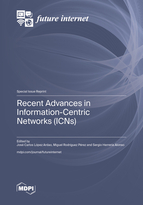Recent Advances in Information-Centric Networks (ICNs)
A special issue of Future Internet (ISSN 1999-5903). This special issue belongs to the section "Internet of Things".
Deadline for manuscript submissions: closed (15 March 2023) | Viewed by 24442
Special Issue Editors
Interests: green networking; virtualization of network functions and services; optimization of communication networks; ICNs & NDN
Special Issues, Collections and Topics in MDPI journals
Interests: green networking; virtualization of network functions and services; ICNs & NDN
Special Issues, Collections and Topics in MDPI journals
Interests: green networking; quality of service in the internet; performance analysis of computer networks; ICNs & NDN
Special Issues, Collections and Topics in MDPI journals
Special Issue Information
Dear Colleagues,
The great success of the Internet has been essentially based on the simplicity and versatility of its TCP/IP architecture, as it imposes almost no restrictions on either the underlying network technology or on the data being transmitted. In essence, applications built on top of TCP/IP get a point-to-point channel that can be used to transmit arbitrary information.
This approach has served quite satisfactorily for many years, but it is no longer well suited to some of the new communication paradigms now being used on the Internet. Nowadays, most applications running on top of the Internet are no longer interested in using a point-to-point channel to exchange traffic between two endpoints. In contrast, what they really want is to obtain some piece of information that is available in the network somewhere. The current use of load balancers and cache overlay networks is an interim solution to address this mismatch between the network communication model and the needs of applications, but such a solution suffers from significant shortcomings. Information-Centric Networks (ICNs), and in particular Named Data Networking (NDN) and CCNx, offer a service where users can directly obtain pieces of information, regardless of their location. This service is more suited to current network uses, and can also be used to provide the traditional point-to-point communication service if so desired.
The purpose of this Special Issue is to present the most recent advances, or comprehensive reviews, relating to ICNs. Potential topics include, but are not limited to:- Design and implementation of global and local ICN approaches
- Routing and forwarding in ICN
- Software design and architectures to support ICN
- Analysis of ICN protocols and applications
- Experiences with ICN implementations
- ICN network management
- ICN security and privacy
- ICN solutions for mobile or constrained environments (5G networks, satellite networks, vehicular networking…)
- SDN-based ICN implementation approaches
- Migration strategies from host-centric TCP/IP networks
- ICN in industrial settings
- Edge-networking and ICN convergence
- ICN and the Internet of Things
- Transport and congestion control for ICN architectures
- Energy efficient networking in ICN
Prof. Dr. José Carlos López Ardao
Prof. Dr. Miguel Rodríguez Pérez
Prof. Dr. Sergio Herrería Alonso
Guest Editors
Manuscript Submission Information
Manuscripts should be submitted online at www.mdpi.com by registering and logging in to this website. Once you are registered, click here to go to the submission form. Manuscripts can be submitted until the deadline. All submissions that pass pre-check are peer-reviewed. Accepted papers will be published continuously in the journal (as soon as accepted) and will be listed together on the special issue website. Research articles, review articles as well as short communications are invited. For planned papers, a title and short abstract (about 100 words) can be sent to the Editorial Office for announcement on this website.
Submitted manuscripts should not have been published previously, nor be under consideration for publication elsewhere (except conference proceedings papers). All manuscripts are thoroughly refereed through a single-blind peer-review process. A guide for authors and other relevant information for submission of manuscripts is available on the Instructions for Authors page. Future Internet is an international peer-reviewed open access monthly journal published by MDPI.
Please visit the Instructions for Authors page before submitting a manuscript. The Article Processing Charge (APC) for publication in this open access journal is 1600 CHF (Swiss Francs). Submitted papers should be well formatted and use good English. Authors may use MDPI's English editing service prior to publication or during author revisions.
Keywords
- ICN
- NDN
- CCNx
- IoT
- 5G
- SDN
- future internet architectures
- new communication paradigms








